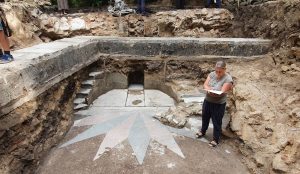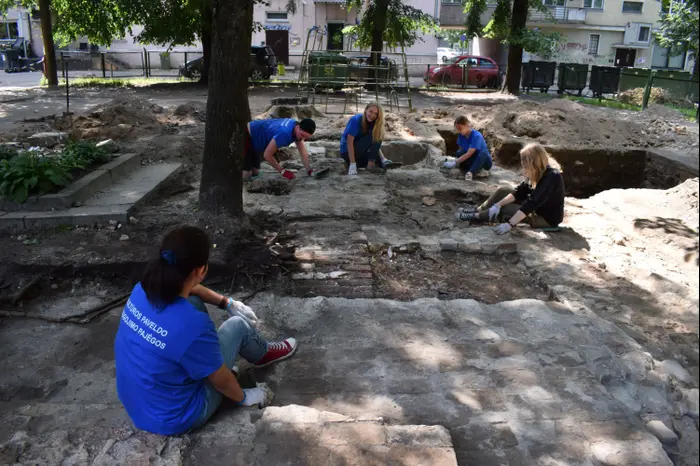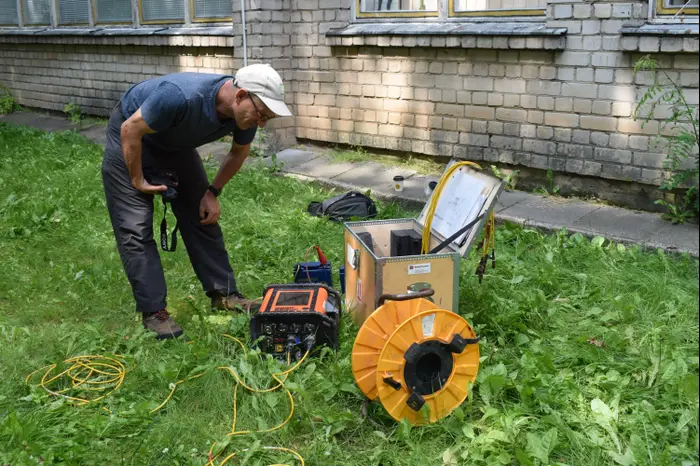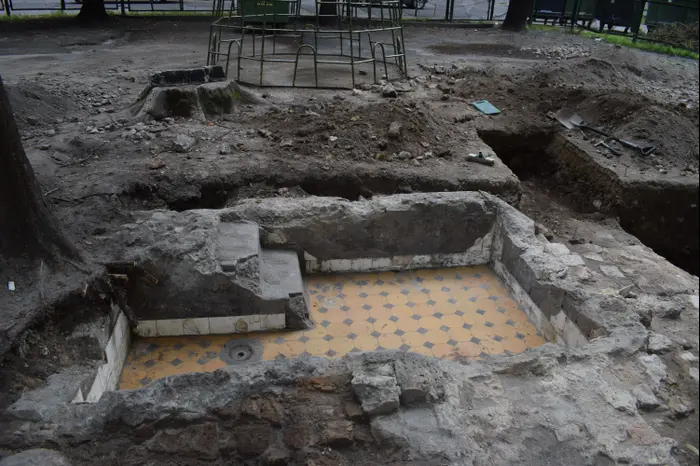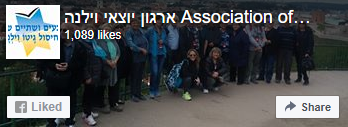Great Synagogue digs
Israeli-Lithuanian Team Reveals Torah Ark at the Site of Vilnius’ Great Synagogue Ofer Aderet/ Aug. 26, 2021
The Great Synagogue, which was destroyed by the Nazis and the Soviets, was built in the 17th century and was part of a larger complex of Jewish institutions that included 12 synagogues or prayer hall.
The Torah ark and bimah – the platform from which prayers were led – have recently been found at the site of the Great Synagogue in Vilnius, the Lithuanian capital. The remnants of the synagogue, which was destroyed by the Nazis and the Soviets, were recently recovered in archaeological excavations at the site, the joint Israeli-Lithuanian archaeology team reported on Thursday.
The team, which is directed by Israel Antiquities Authority archaeologist Dr. Jon Seligman, has now wrapped up its sixth annual season of digs at the site, which began with ground-penetrating radar testing at the site in the city, which is known in Yiddish as Vilna. The city was a major center of Jewish life prior to the Holocaust.
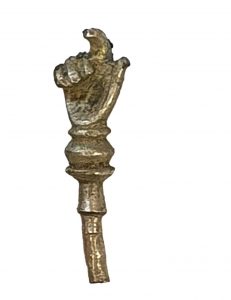
The silver Yad found during the excavation.Credit: Jon Seligman / Israel Antiquities Authority
The Great Synagogue was built in the 17th century in Renaissance-Baroque style and was part of a larger complex of Jewish institutions that included 12 synagogues and prayer halls and ritual baths. On Thursday morning, while sifting earth at the site, a silver Torah pointer, yad in Hebrew, was discovered, which had been used at the Great Synagogue.
During the Holocaust, the site was plundered and burned by the Nazis and then in 1956 to 1957, what remained of the building was demolished by the Soviet authorities. Lithuania was a republic of the Soviet Union at the time and a school was built at the site.
A number of years ago, Seligman visited the site as part of a Jewish roots trip and decided to undertake the excavations there. “When we arrived to excavate the aron kodesh [Torah ark] and the bimah, from which generations of Jews read the Torah scroll for 300 consecutive years, it became clear, unfortunately, that the core of the synagogue had been greatly damaged by Soviet destruction,” he said.
Two staircases, which are clearly visible in old photos of the synagogue, had been destroyed but the archaeology team found evidence of their prior presence. In front of the ark, the remains of which were also discovered in the most recent season of excavations, a decorative floor was found depicting rays of the sun. In the course of the excavations of the bimah, the team also recovered one of four huge pillars that supported the synagogue’s roof.
The excavations were sponsored by the Israel Antiquities Authority, the Good Will Foundation, the Jewish community of Lithuania and Kultūros paveldo Išsaugojimo pajgos, a preservation organization.
Great Synagogue of Vilna, Ravaged by Foes, Yields Treasures and a Priceless Hebrew Inscription
By Laura Geggel , Live Science, July 23, 2019
 Inside the buried remains of the Great Synagogue of Vilna in Lithuania, archaeologists have found a priceless inscription, colorful floors, piles of coins and parts of the bimah (bee-ma) — the structure where the Torah is read and Jewish services are led, according to the Israel Antiquities Authority (IAA).
Inside the buried remains of the Great Synagogue of Vilna in Lithuania, archaeologists have found a priceless inscription, colorful floors, piles of coins and parts of the bimah (bee-ma) — the structure where the Torah is read and Jewish services are led, according to the Israel Antiquities Authority (IAA).
The findings are remarkable because the synagogue, historically referred to as the "Jerusalem of the North," was badly burned during World War II and later razed by the Lithuanian Soviet authorities in 1957, said Jon Seligman, the director of the synagogue's excavation and an archaeologist with the IAA.
"The Great Synagogue is the most important synagogue of Lithuania," Seligman told Live Science. "It became no less than the cathedral of the Jews of the city."
Even after it was destroyed — and a kindergarten and a primary school were built over it — archaeologists knew where the synagogue's remains were located. But with the exception of a small excavation by Lithuanian archaeologists in 2011, the site wasn't thoroughly examined until 2015, when Seligman and his colleagues used ground-penetrating radar to pinpoint the historic building's ruins before digging them out.
As excavations began, the archaeologists, including Justinas Račas of the Cultural Heritage Conservation Force of Lithuania, began finding remarkable treasures. They located two ritual baths, known as mikvahs; part of the bimah; and floor tiles, Live Science reported last year.
This past season, the archaeologists found the bimah's front section, which was originally two-stories tall in the 18th century. They also found seating plaques, a floor with beautiful red-and-black geometric designs, and a cellar underneath the bimah, which held a prayer book from before the Holocaust. In addition, there were about 200 coins dating from the 16th to the 20th centuries, and buttons from Napoleon's army, likely from when French troops passed through Vilnius before being defeated in Moscow in 1812, Seligman said.
The most important finding, however, was a large inscription that two sons had made in honor of their parents in 1796, Seligman said. This inscription "was part of a stone Torah reading table that stood on the magnificent Bimah of the synagogue in Vilnius," Seligman and Račas said in a statement from the IAA.
The two brothers — Rabbi Eliezer and Rabbi Shmuel — honored their mother, Sarah, and their father, Rabbi Chaim, who had emigrated from Lithuania to Eretz Israel and settled in Tiberias, according to the Hebrew inscription. This inscription illustrates the deep connection the Lithuanian Litvak community felt toward the
Bustling city
Vilnius became a major Jewish city starting in the 14th century, when the Lithuanian king gave Jewish people permission to settle there, Seligman previously told Live Science. At first, the synagogue was built out of wood, but in the 1600s, Italian and German architects rebuilt the city in brick, including the famed Great Synagogue.
After a fire in 1748, the synagogue was rebuilt by benefactors. But the city's authorities didn't want the synagogue to tower over its churches, so parts of the synagogue were built below street level, which is why so much of it is preserved today, Seligman previously told Live Science.
Tens of thousands of Jewish Lithuanians died in Lithuanian ghettos and concentration camps in Eastern Europe during World War II. To honor these people, as well as the Great Synagogue, the city plans to create a Jewish memorial center at the site by 2023, when Vilnius celebrates its 700th birthday, the AFP reported last year

